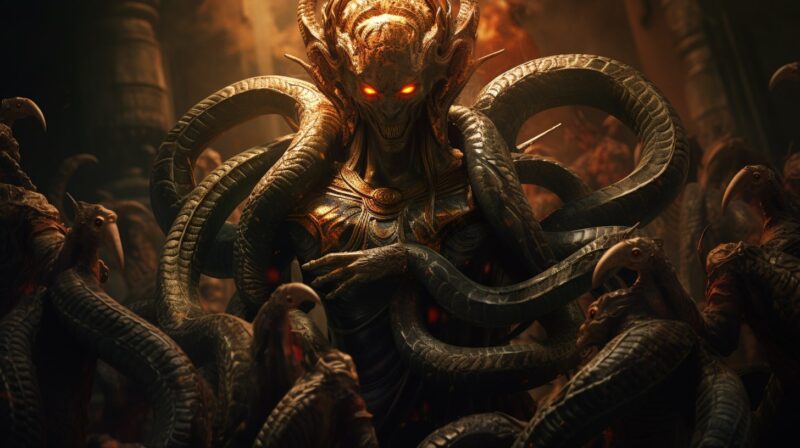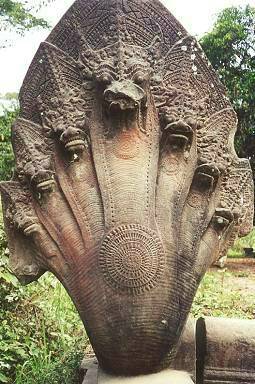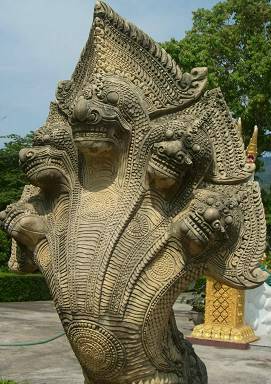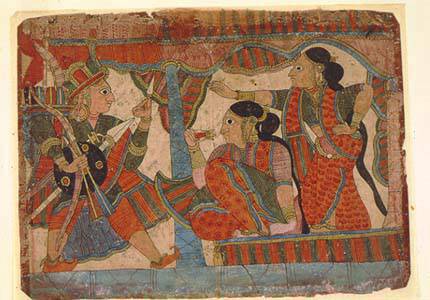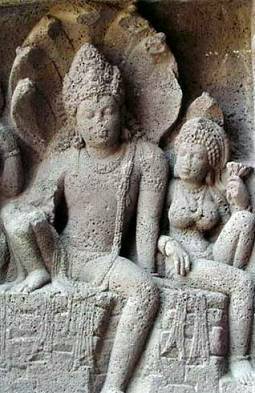Nagas – semidivine demons or demigods with a snake trunk and one or several human heads. The most ancient Indian legends mention that the civilization of Nagas was powerful at the dawn of mankind; they inhabited under the mythical Mount Meru.
In the first book of the “Mahabharata” (“Adi Parva” or “The Beginning”) they are described as living on land. Then Brahma had opened wide land and they were descended under it.
Having moved in the subterranean world, Patala, nagas had built to him(her)self dazzling palaces shining with gold and jewels. The wise dragon Vasuki became the tsar (king) and ruled in their subterranean city Bhogavati, filled with unprecedented land treasures.
Tsars (Kings)
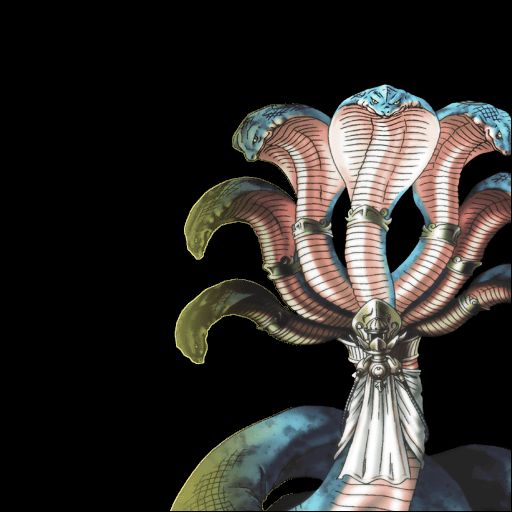
In the Indian myths names of many tsars (kings) are named among which the most known are: the thousand-headed dragon Shesha supporting Earth and serving by a bed for Vishnu during his sleep at the ocean in intervals between creations of the world; Vasuki, used by gods and demons in the capacity of ropes at the Churning of the ocean for the purpose obtaining of amrita – a beverage of immortality; Takshaka and Ayravata.
Regal snakes, three-headed, five-headed, seven-headed, and ten-headed are powerful and wise, their heads are topped by precious coronas; for their virtue (and often for long self-sacrifice or asceticism) they have got into favor and friendship of gods.
Outside of India Nagas are compared with local snake-like deities. For example, with lu in Tibet, naty in Burma, praya nak in Laos, and dragons – lungs in China.
Descriptions and images
They are described in many Vedic texts, epic poems, Puranas, Buddhist sutras, and also in some canonical Buddhist texts, for example, “The Jataka”. Their images are presented on bas-reliefs of Angkor in Cambodia, on bridges of Nagas in the temple of Phimai in Thailand, in Phnom Rung temple, disposed on the royal road from Angkor to Phimai, and in other places.
In spite of the abundance of mentions of Nagas in the Old Indian literature, their appearance is always too general (if they are not imaged in the form of people).
The impression is created that compilers of legends simply did not know, how these beings looked, and nearly always (consciously or unconsciously) identified them with snakes. Such are nagas and bas-reliefs created in much late times.
How Did They Look?
They had one or several (two, three, five, seven, etc.) human heads without a hair and a trunk with a widened neck of a cobra with one pair of legs or quite without legs. Nagas were colored in blue, green, red, black, and white colors and wore various clothes.
For example, Shesha was imaged in a purpuric vestment with a white necklace around his neck, the sister of Vasuki, perfectly folded Jaratkara, – apparelled in beautiful clothes and decorated with jewelry.
“[Nagas] from a stem of Vasuki… were blue, red, and white colors: all of them had huge, abominable trunks overfilled with deadly venom. Their names – Kotika, Manasa, Purna …
[Nagas] from the family of Dhritarashtra. These snakes … could move with the speed of the wind and were awfully venomous. Here they are – Shankukarna, Pingalaka, Kutharamukha …” (“Mahabharata”)
On frescos of Sigiria which some explorers compare with Lanka from the “Ramayana”, the Royal Palace in Bangkok, and some other places there are images of perfectly folded girls or women with green skin. Perhaps, it is the most realistic image of Nagas?!
According to the “Mahabharata”, “some of them [Nagas or dragons] were small, precisely mice, others were in an elephant’s trunk, third resembled on … elephants … with all diversity of their colors…”; “all … monstrous snakes possessed such huge force and were such colossal value that when mounted on tailings, resembled mountain peaks. Some of them come up in length one yodzana, and some even in two yodzana”.
Capacities and Habits
Old Indian legends have handed down to us much more data on their capacities and habits. So, it almost everywhere speaks that nagas were extremely venomous creatures and their bite and breath were considered fatal. Fatal (or having a huge hypnotic force) was even a gaze of Nagas.
Their venom (Vasuki, Takshaka, etc.) was often compared with fire, and lightning, and could incinerate all alive. The following fragments from the “Mahabharata” as if prove it:
“Their awful venom could burn, as a flaming flame”;
“From igneous snake venom the house on a stage has flared at once and… has tumbled down as if bringed down by a lightning”.
They were unusually clever and artful creatures. Their basic tactics of conducting a struggle with people, gods and demons were an ambush, an unexpected assault, magic, and venom.
Nagas were considered wise men, magicians, and wizards, capable to revive the dead and to change their external appearance. They perfectly possessed the art of maya, could penetrate through a hard fabric, and suddenly occur and disappear. Being great sorcerers, they had the capacity to call for fire, rain, storms, and other physical elements of nature.
Teachers of Magic and Authors of Books
According to one legend, Apolloniy Tiansky – contemporary of Jesus Christ, the main representative of the new Pythagorean school – had been trained magics by Nagas of Kahmir.
In the mythology of the Vajrayana, they were revered as savers of trues of Buddhism.
In the mythology of the Mahayana, there are mentions of how the known Buddhist reformer Nagardzhuna got the sutra “Pradzhnjaparamita” from Nagas which safeguarded it until people not ripened to understand it.
The court historian of emperor Akbar Abul Fazl (XVI century) have written in his book that in ancient times the book “Nilmat” (it has laid in the basis of the “Nilamat Purana”) come to the surface from the depths of Nilanag lake in Kashmir. This book contained a detailed description of Kashmir and its history. This book has allegedly been written by Nilanag – Blue Naga.
Immortal Beings-Werewolves, Able to Fly
Some Nagas, for Example, Takshaka, Knew how To Fly:
“They looked, how the sovereign of dragons … Takshaka …, has flyed…, blazing bright as if lotuses of all colours, paints, and, it appears, a hair of heaven flies apart from it extensively. From igneous snake venom the dwelling on a stage has flared at once, and hardly imperial court had time to escape, has crashed down, precisely tumbled down by a lightning”.
The “Mahabharata” tells that Nagas have received immortality, having tried amrita, but thus their tongues have bisected, because they had to lick amrita from acute stems of a grass kusha.
Nagas could transform into men and not infrequently had intimacies and marriages – both with man, and with women.
Marriages of Nagas with people
Nagas lived often enough in a human appearance among people. Similarly, people sometimes lived together with Nagas in their world. And in that and the other case full-blown descendants were born from their marriages.
An example of that is the wise man Astika who was born from the marriage of Vasuki’s sister, Nagini Jaratkaru, and the wise man Jaratkaru and has left after himself with children and grandsons.
Women of nagas – Nagini, famous for their beauty, quite often became wives of mortal tsars (kings) and heroes. So, the hero of the “Mahabharata” Ashvatthaman, son Drona, married the queen-Nagini; tsarevna-Nagini Ulupi spent one night with another hero of the “Mahabharata”, Ardzhuna, and Nagini Kumudvati became a wife of Kusha, the son of Rama.
In ancient India, Nagas were connected with the fertility of fields and grain yield. In China they are considered earth deities – savers of five orbs and four cardinal points and center.

